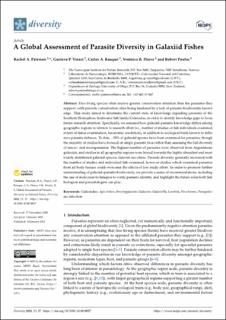| dc.description.abstract | Free-living species often receive greater conservation attention than the parasites they
support, with parasite conservation often being hindered by a lack of parasite biodiversity knowl edge. This study aimed to determine the current state of knowledge regarding parasites of the
Southern Hemisphere freshwater fish family Galaxiidae, in order to identify knowledge gaps to focus
future research attention. Specifically, we assessed how galaxiid–parasite knowledge differs among
geographic regions in relation to research effort (i.e., number of studies or fish individuals examined,
extent of tissue examination, taxonomic resolution), in addition to ecological traits known to influ ence parasite richness. To date, ~50% of galaxiid species have been examined for parasites, though
the majority of studies have focused on single parasite taxa rather than assessing the full diversity
of macro- and microparasites. The highest number of parasites were observed from Argentinean
galaxiids, and studies in all geographic regions were biased towards the highly abundant and most
widely distributed galaxiid species, Galaxias maculatus. Parasite diversity generally increased with
the number of studies and individual fish examined, however studies which examined parasites
from all body tissues could overcome the effects of low study effort. In order to promote further
understanding of galaxiid–parasite biodiversity, we provide a series of recommendations, including
the use of molecular techniques to verify parasite identity, and highlight the future roles both fish
biologists and parasitologists can pla | en_US |

